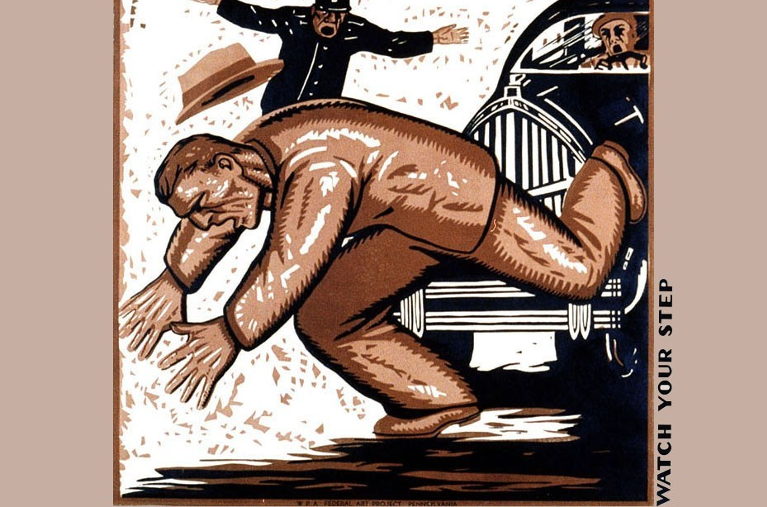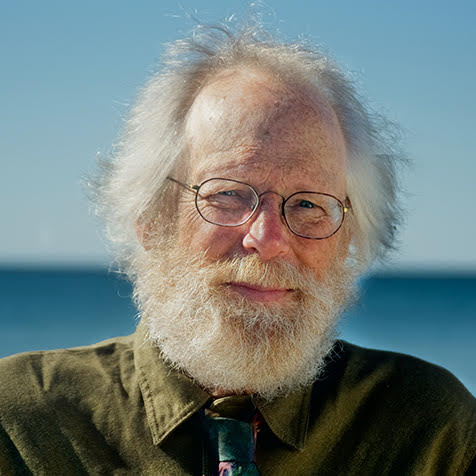Confronting the legal web that enforces drivers’ privilege
Why is car culture so dominant in North American life? Is it a matter of personal preference, or is it the result of extensive advertising?
Those are important factors – but University of Iowa law professor Gregory H. Shill says that auto dominance has also been cemented by a myriad of laws that favour drivers and discriminate against non-drivers.
In a new paper entitled “Should Law Subsidize Driving?” Shill writes:
“There exists a vast system of legal rules that offer indirect yet extravagant subsidies to driving, artificially lowering its price by offloading its costs onto non-drivers and society at large. Rules embedded across nearly every field of law privilege the motorist and, collectively, build a discriminatory legal structure with no name.” (Shill, “Should Law Subsidize Driving?”, 2019, page 3)
The paper discusses privileges for drivers in, among other areas, criminal law, civil liability, the method of setting speed limits and the lax enforcement of those limits, mandated dedication of public space to parking, zoning laws that favour low-density development, use of general tax revenues to cover nearly the entire costs of road construction and maintenance, and vehicle safety standards that ignore vulnerable road users.
This promotion of driving coincided with the financial interests of the largest industries – car-making and petroleum extraction – and Shill argues that it also worked to maintain racial segregation.
Far from a dry legal treatise, Shill’s paper is one of the best studies you will find of the social costs of car culture in the US. A great deal of his analysis applies in Canada as well.
Get off the road, idiot!
People in North America now take for granted that cars have the right of way on public roadways, while pedestrians and cyclists enter these streets at great personal risk. But when this grand theft by auto of public right of way was beginning, the reaction was widespread revolt.
“In cities, the contemporary reaction in the 1910s and 1920s was one of fear and outrage: whereas the street had previously been a relatively safe place for people to amble, with the tacit approval of local authorities it had in a very short period of time been transformed into a wildly dangerous place where motorists killed and maimed large numbers of people with impunity. Urban pedestrians, and especially children, suffered disproportionately. A class element predominated as well, as cars were a luxury at this time and many children killed in urban streets were poor.” (Shill, 2019, page 21)
Toronto Telegram, May 26, 1934. The lead says “KING OF THE KILLERS! Greatest menace to human life smirks at law – total penalty for thirty-one killings is merely four and one-half years in prison.”
Many people were deeply offended that well-to-do motorists not only killed pedestrians, but typically paid no or minimal legal penalties for doing so. As Shill documents, this pattern remains true today. And where regulatory remedies seemed to be called for, the response was generally to create greater legal tolerances for errant drivers.
He notes that there was a serious move to install automatic speed limiters in cars – in the 1920s – but the forces of “motordom” mobilized a campaign of public relations and legal changes. One result is that the term “jaywalking” was enshrined in law as an offense, and another is that speed limits were rapidly raised to favour heavy-footed drivers. (Though it was already clearly understood that speed kills.)
Ironclad suggestions
A new method for setting speed limits became standard across the country: the limit is set as the speed under which 85 per cent of drivers will drive on a given road in “free flowing traffic”. As Shill explains, this standard method promotes fast vehicle movement but is counterproductive to public safety:
“if the speed limit on a given residential street is 30 mph, but 85 percent of drivers travel on the road at or below 40 mph, the speed limit will be raised to 40 mph. If raising the speed limit prompts drivers to drive even faster, such that 85 percent now drive 45 mph, the speed limit will be raised again.” (Shill, 2019, page 14)
Finally, there are few places in the country where speed limits are actually enforced; rather, a wide allowance is expected and accepted by both drivers and law enforcement, such that drivers driving only five or 10 miles/hour above the speed limit are seldom ticketed.
Although technologies for automated detection and ticketing of speeders have been known for many years, this way of enforcing the law is often outlawed:
“So dissonant are social attitudes towards speed limits that some jurisdictions do not permit and in some cases expressly forbid automated enforcement of speed laws. They are ironclad suggestions.” (Shill, 2019, page 10)
Shill contrasts the systematic tolerance of speeding and other driving infractions with harsh treatment for transportation-related offenses by non-drivers.
“[T]he maximum penalty for a parking meter or HOV [High Occupancy Vehicle] lane violation is a ticket, while boarding a subway or light rail without paying can trigger not only a fine but arrest. … [D]elaying 50 bus passengers by temporarily parking in the bus lane is punishable by ticket, but boarding that same bus with an expired pass can trigger jail time.” (Shill, 2019, page 73-74)
The institution of sprawl
The widespread adoption of automobile ownership a century ago immediately created a new problem. Auto owners would not own a space in which to store their cars in all the places they might visit. As Shill notes, a free market system could have met this need through charging whatever the market would bear, in each location – but that would have imposed significant costs on motorists, thereby lessening the demand for cars.
In response, cities and states rapidly changed laws to provide free public space for the storage of cars – and in the process they redefined a common word:
“By the 1920s, city parking authorities ‘began cutting down street trees and widening streets to accommodate the volume of cars, thereby replacing the original meaning of parking as a place for trees and greenery with parking as a place for automobiles to stop.’” (Shill, 2019, page 23, quoting from Michele Richmond, The Etymology of Parking, 2015)
This free use of space, Shill notes, is not for just any use:
“street parking is reserved for cars. Try ‘parking’ a picnic table, tiny home, or above-ground pool there and you will soon discover that motor vehicles are generally the only type of private property that it is lawful to store for free on the public street. The car yields to nothing in its consumption of public subsidy.” (Shill, 2019, page 48)
Devoting a big share of residential street space to fully subsidized parking was not enough. Zoning rules across the country also mandated that new buildings – apartments, office complexes, retail developments – must also include generous amounts of parking space.
Shill discusses such zoning rules extensively, as part of a web of rules that systematically favour low-density development where regular car use is a necessary part of daily life – at great cost to public budgets, and even greater personal cost to those who can’t afford cars.
A human sacrifice every six minutes
As Shill explains, the capture of right of way by cars has always been bloody and it has always been discriminatory, since non-motorists on the roads (now termed “vulnerable road users”) are disproportionately poor and visible minorities. But of course motorists themselves also pay with their lives at a high rate.
Today in America the great majority of adults are drivers and car-owners, yet even among drivers there is a deadly class division. The American auto industry strongly favours large, heavy vehicles which sell for a much higher price and bring a much larger profit margin. The saturation advertising campaigns for these vehicles feature, on the one hand, their awesome power and their thrilling speed, and on the other hand, the extensive safety features that supposedly keep the cars’ occupants in a cocoon of security.
Ironically, though, the bigger and heavier the cars get, the deadlier are the roads – particularly for vulnerable road users, but also for drivers of smaller cars.
The auto industry originally secured a loophole for “light trucks” in order to escape fuel efficiency standards. The ubiquitous “Sport Utility Vehicle” falls into that category, and so do the hulking, four-wheel-drive, four-door pickup trucks you now see scattered through the parking lots of every suburban grocery store.
With their high front ends these vehicles kill pedestrians and cyclists at a particularly high rate. Whereas a pedestrian or cyclist struck by an old-fashioned sedan will typically be hit at the legs, and will be lifted up and onto the hood (“bonnet”) of the car, the same vulnerable road user will be hit right in the vital organ zone when struck by a “light truck”, and will likely be knocked down and run over. The result:
“Research shows that a pedestrian is 3.4 times as likely to be killed if struck by an SUV or other light truck than if hit by a passenger car.” (Shill, 2019, page 58)
But drivers of lower-priced cars also share the social costs:
“SUV-to-car crashes are also far graver. ‘In frontal crashes, SUVs tend to ride over shorter passenger vehicles, crushing the occupant of the passenger car.’ In head-on collisions with SUVs, drivers of passenger cars are between four and 10 times more likely to die than in collisions with other passenger cars.” (Shill, 2019, page 64-65, quoting from Tristin Hopper, “Big Cars Kill”, National Post, July 31, 2015)
There is no natural law that says car safety ratings should take into account only the safety of the car’s occupants while discounting the safety of other road users. In fact, in some countries the legal framework governing car design is quite different:
“The United Nations has issued a regulation designed to protect pedestrians, which had been adopted by 44 countries—many of them our peers in Europe—as of 2015. The United States has taken no action.” (Shill, 2019, page 63)
Here too, US law offloads the social cost of driving, in this case the social cost of driving high-frame vehicles, onto the general public.
There is much more in Shill’s almost book-length monograph and it is well worth a careful read. He summarizes the effect of an elaborate legal web of privilege with these words:
“The car’s needs are given priority over the right of society to health and welfare, affordable homes, and economic vitality. Car supremacy claims one human sacrifice every six minutes‡, bakes the planet, and enforces race and class inequality. It is not endemic because it is just, it is ‘just’ because it is endemic—and blessed by law.” (Shill, 2019, page 76)
He adds that “The task of repealing car-centric laws that justify and solidify bad outcomes is formidable. If it succeeds, it will take the labor of more than one generation.” I sincerely hope he is wrong about that timeframe.
Graphic at top of article is adapted from an anti-jaywalking poster produced by the Public Art Project of the Work Projects Administration (WPA). Students of history will recall that the WPA was a prominent job-creation agency of the New Deal. Let’s hope that the Green New Deal will not sponsor propaganda boosting continued auto dominance.
‡One human sacrifice every six minutes refers, of course, just to the casualties in the United States. Worldwide, about two people per minute die in traffic accidents.







